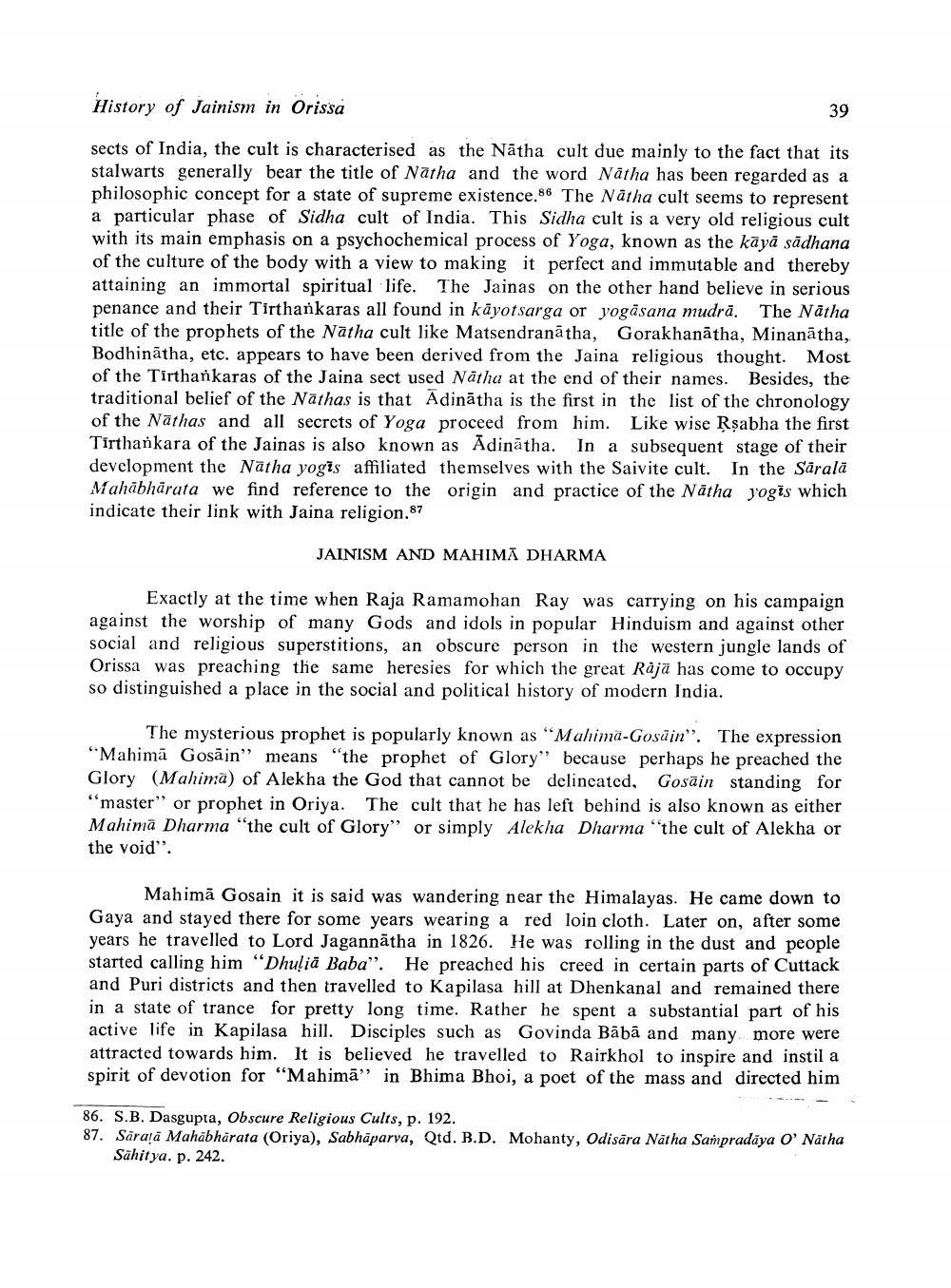________________
History of Jainism in Orissa
39
sects of India, the cult is characterised as the Nātha cult due mainly to the fact that its stalwarts generally bear the title of Natha and the word Nätha has been regarded as a philosophic concept for a state of supreme existence.86 The Nātha cult seems to represent a particular phase of Sidha cult of India. This Sidha cult is a very old religious cult with its main emphasis on a psychochemical process of Yoga, known as the kāyā sādhana of the culture of the body with a view to making it perfect and immutable and thereby attaining an immortal spiritual life. The Jainas on the other hand believe in serious penance and their Tirthankaras all found in kāyotsarga or yogāsana mudrā. The Natha title of the prophets of the Natha cult like Matsendranātha, Gorakhanātha, Minanātha, Bodhinātha, etc. appears to have been derived from the Jaina religious thought. Most of the Tirthankaras of the Jaina sect used Nātha at the end of their names. Besides, the traditional belief of the Nathas is that Adinātha is the first in the list of the chronology of the Nathas and all secrets of Yoga proceed from him. Like wise Rşabha the first Tirthankara of the Jainas is also known as Adinātha. In a subsequent stage of their development the Natha yogis affiliated themselves with the Saivite cult. In the Sāralā Mahābhārata we find reference to the origin and practice of the Natha yogis which indicate their link with Jaina religion.87
JAINISM AND MAHIMA DHARMA
Exactly at the time when Raja Ramamohan Ray was carrying on his campaign against the worship of many Gods and idols in popular Hinduism and against other social and religious superstitions, an obscure person in the western jungle lands of Orissa was preaching the same heresies for which the great Rajā has come to occupy so distinguished a place in the social and political history of modern India.
The mysterious prophet is popularly known as "Mahima-Gosain". The expression “Mahimā Gosājn" means "the prophet of Glory” because perhaps he preached the Glory (Mahima) of Alekha the God that cannot be delineated, Gosāin standing for "master" or prophet in Oriya. The cult that he has left behind is also known as either Mahima Dharma "the cult of Glory" or simply Alekha Dharma 'the cult of Alekha or the void".
Mahimā Gosain it is said was wandering near the Himalayas. He came down to Gaya and stayed there for some years wearing a red loin cloth. Later on, after some years he travelled to Lord Jagannātha in 1826. He was rolling in the dust and people started calling him “Dhulia Baba". He preached his creed in certain parts of Cuttack and Puri districts and then travelled to Kapilasa hill at Dhenkanal and remained there in a state of trance for pretty long time. Rather he spent a substantial part of his active life in Kapilasa hill. Disciples such as Govinda Bābā and many more were attracted towards him. It is believed he travelled to Rairkhol to inspire and instil a spirit of devotion for "Mahimā" in Bhima Bhoi, a poet of the mass and directed him
86. S.B. Dasgupta, Obscure Religious Cults, p. 192. 87. Sāra!ā Mahābhārata (Oriya), Sabhāparva, Qtd. B.D. Mohanty, Odisāra Nātha Sampradaya O' Natha
Sahitya. p. 242.




